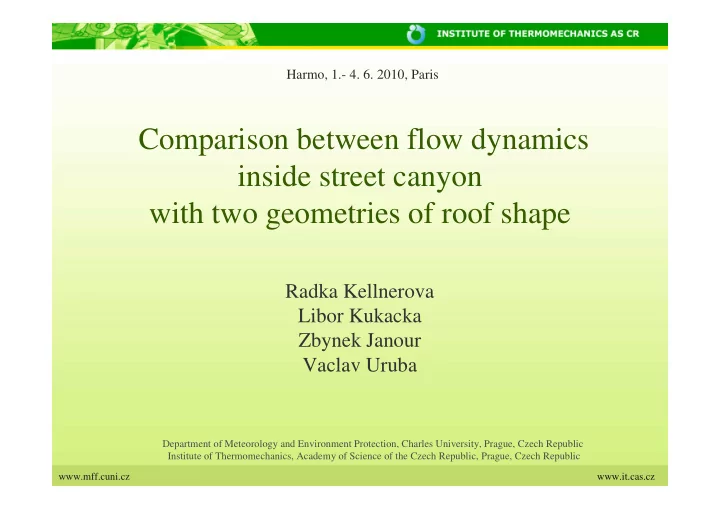

Harmo, 1.- 4. 6. 2010, Paris Comparison between flow dynamics inside street canyon with two geometries of roof shape Radka Kellnerova Libor Kukacka Zbynek Janour Vaclav Uruba Department of Meteorology and Environment Protection, Charles University, Prague, Czech Republic Institute of Thermomechanics, Academy of Science of the Czech Republic, Prague, Czech Republic www.mff.cuni.cz www.it.cas.cz
Ventilation of the street canyon Different roof shapes produce different dynamics - stationary and intermittent (Barlow, 2007) effect on ventilation. Skewness of velocity brings an information about Janet F.Barlow and Bernd Leitl, 2007 apperance of intermittent motion. 3. moment H/W=1 Sk W = <w’ 3 >/ σ w 3 H/W=1 R/W=1/3 H...Height of street W...Width of street R...height of Roof
Experimental set-up – Wind tunnel 2-D model Scale 1:400 Building B/H= 1 Width W/H = 1 Roof R/W=0.4 ����� ������ ����� ������ Measurement: 32 rows upstream Cross-section 1.5 m x 1.5 m 10 downstream Reference wind speed 3 m/s Model scale Full scale H = 5cm ≈ H = 20m LDA 2-D components Focal length 400 mm Data rate 200 - 600 Hz Reynolds number Re 2H = 10 000 Volume 0.2 x 0.2 x 5 mm 3 Acquisition time 180 s λ P = 0.5 λ F = 0.5 Blockage 3.3%
Vertical skewness Vertical penetration is strongest on the windward side. 2 Recirculation tends to speed up. 1.8 Wind direction 1.6 1.4 W Skewness 1.2 1.2 Z/H 1 1 0.8 0.6 0.8 0.4 0.2 0.6 0 -0.2 0.4 -0.4 -0.6 0.2 -0.8 -1 0 -1.2 -3 -2.5 -2 -1.5 -1 -0.5 0 0.5 1 X/H Negative skewness extents over whole roof area with extreme behind the upstream edge. 2 This could rather disturb a ventilation. 1.8 Wind direction 1.6 1.4 W Skewness 1.2 1.2 1 Z/H 1 0.8 0.6 0.8 0.4 0.2 0.6 0 -0.2 0.4 -0.4 -0.6 0.2 -0.8 -1 0 -1.2 -3 -2.5 -2 -1.5 -1 -0.5 0 0.5 1 X/H
Momentum flux Large deflection in momentum flux profiles above flat and pitched roof (Rafailidis, 1997). Momentum flux exhibits maximum just at roof-top level. Magnitude is double for pitched roof. Parameters difference Flat roof generates “rough“ turbulent BL. Pitched roof generates “very rough“ BL. VDI manual, 2000
Quadrant analysis Sweep/ejection dominates in urban canopy layer. Events in term of occurence are in balance above. Δ Δ S = Sweep - Ejection Δ Δ Sweep Ejection
Experimental set-up: Wind channel ����� �� �� ������������ ������ ������ �������� ��� �� �� ��� ��� ������� Measurement: 20 rows upstream, 10 downstream PIV Diode pumped Nd:YLF Repetition 500 -1000 Hz Camera resolution 1280 x 1024 pxs Interrogation area 32 x 32 pxs Overlapping 50% (80 x 64 vectors) Cross-section 0.25 m x 0.25 m Energy 10 mJ Reference wind speed 5 m/s Area 100 x 100 mm Acquisition time 3.2 s Reynolds number Re 2H = 40 000 λ P = 0.5 λ F = 0.5 Blockage 20%
Wavelet analysis Wavelet analysis can decomposed signal into the frequencies and detects the time of their appearance . Morlet function is used as a mother wavelet ( ω 0 =6). Daughter wavelet is inferred via dilation s and translation in time t from mother. Computation is run in Fourier space using algorithm of Torrence & Compo (1997) and Ge (2007). Square of modulus of complex wavelet coefficient => Power spectra: 10 -1 10 -2 2 f*S UU / σ -3 10 Fourier Power spectrum Wavelet Power spectrum Theory - Karman -4 10 10 -2 10 -1 10 0 10 1 10 2 Frequence [Hz]
Wavelet analysis High correlation between u’ and w’ fluctuation – large momentum flux. Flow produces mostly sweep or ejection event. Large areas indicate passing the sweep or ejection “waves” rather than vortex. 10 Hz Pitched roof 5 Hz 10 Hz 21 Hz 36 Hz 3.5 Hz 12 Hz 40 Hz 60 Hz
Wavelet analysis Subtraction of proper convective velocity reveals circular vortex core (Adrian, 2000). Pitched roof 84 Hz Deviation of convective velocity from advective one. Advective velocity <u>=3.4 m/s λ ≈ 40 ± 2 mm Convective velocity u c =2.5 m/s λ ≈ 29 ± 2 mm PIV λ ≈ 22 ± 2 mm Subtraction of 2.5 m/s.
Vorticity Vorticity is calculated using Stokes theorem. 500 Hz 1000 Hz
Vortex tracking Swirling strength and 2 nd invariant Q is compared to the vorticity and vector field. Swirling strength (Zhou, 1996) Subtraction of 2 m/s 2 nd invariant Q (Chong, 1990) Vorticity
POD modes POD (Lumley, 1967) re-expresses data set into new orthogonal basis. Snapshot POD (Sirovich, 1987) was applied on 2-D velocity data (N=1634 and 3270). Dominant modes of flow in street canyon:
POD convergence Analysis of velocity data yields relative contribution to TKE for each mode. Fast convergence of cummulative contributions witnesses about more organised structure of flow. Recirculation Zone (RZ) captures generally less turbulent kinetic energy. SL and RS involve larger TKE contribution and more coherency. Pitche d roof Accumulative re lative contribution [% ] Pe rce ntage of mode s RZ SL RS 1% 56 77 84 10% 89 96 98
Conclusion Flat and triangle roof generate turbulent flow of different category. Flat roof produces smoother flow, less turbulent with conveniently localized intermittent propagation of fresh air into canyon on windward side. Recirculation zone is more stable and ventilation is more effective. Pitched roof induces violent, disturbed flow with intensive vortex penetration into the cave. Perturbations affect recirculation zone and damage the natural ventilation. Shear layer contains more coherency than recirculation zone. Flat roof induces less coherent flow than pitched roof.
Thank you for your attention
Recommend
More recommend